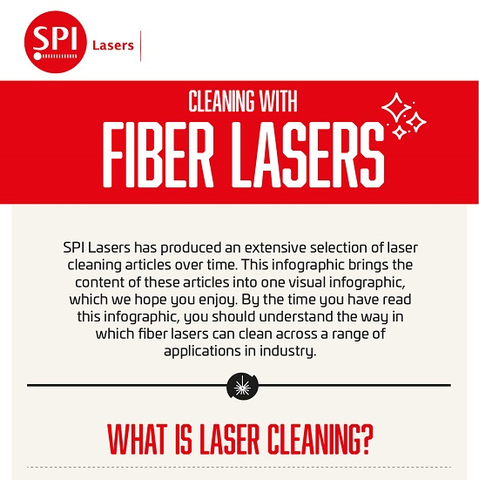The Effectiveness of Cleaning with Fiber Lasers Discussed by Matt Wallis of SPI Lasers
December 08, 2018 (PRLEAP.COM) Business News
Laser cleaning is fast becoming one of the most accepted processes in industrial cleaning across the world. Traditional methods of industrial cleaning are being sidestepped in favour of the more efficient, precise and low-cost deployment of fiber lasers. It's unsurprising then that this was the topic of a recent infographic from global lasers manufacturer, SPI Lasers.SPI Lasers have put together a comprehensive infographic, in order to build awareness of how laser cleaning works. The infographic is presented in a compelling visual manner, combined with simple, lucid language so that anyone can understand how laser cleaning works and its various applications and benefits across the industry.
"Staying away from industry jargon is an important choice we made, as we want more and more people to understand what laser cleaning is and how it can deliver benefits to their businesses in the long run", said Matt Wallis of SPI Lasers. We spoke to Matt to find out more about this revolutionary new technology and how it works.
"Laser cleaning uses pulsed fiber laser beams, accurately pointed at the surface in order to remove unwanted materials such as debris, grease, contaminants, etc. The unwanted layer on top is heated up through controlling the output power and the wavelength of the laser beam", explained Matt. "Eventually, the purpose is to vaporise the material altogether, leaving the surface clean and pristine. The process is very similar to laser ablation, however, in this case, the focus is completely on cleaning the surface".
Although the concept is fast becoming popular now, the technology was originally born in the early 90s. Interestingly, at the time laser cleaning was used to clean stone surfaces as part of restoration projects. In 1993, a major restoration project at the Amiens Cathedral, a UNESCO World Heritage site, used laser cleaning with great results. Thereafter, the first laser cleaning machine called NL 101 was released by B.M. Industries.
SPI manufactures fiber lasers, which are extremely advantageous for the cleaning process. The benefits to industry are manifold. Firstly, the process is less hazardous for members of staff, as no chemicals or solvents are in use throughout the process. Therefore, the operation is less messy. Additionally, the process is environment-friendly as there is minimal waste generated at the end of the operation. Most of the unwanted material is vaporised, leaving very small quantities of particulate matter, which can be cleaned easily.
Laser cleaning is today used across the industry in different processes. As the process is completely automated, there is very minimal human intervention. Being a non-contact process, safety is paramount. In addition, the process is far less energy-intensive, when compared to other traditional methods of industrial cleaning, such as micro-sandblasting and media blasting. Due to these advantages, the overall cost of operation is greatly reduced, making it highly attractive across the industry.
"Cost is only a small part of the advantages of using laser cleaning. The precision that can be achieved with laser cleaning has been a game changer for the industry", said Matt. "We call this micro-cleaning, in which small parts and surface areas which cannot be easily accessed are cleaned using lasers. Of course, the other big advantage is speed. The level of perfection and the speed at which it can be achieved is simply phenomenal. It is unthinkable for traditional methods to achieve this, especially where human intervention is required".
Since lasers are capable of cleaning delicate materials, without damaging them, it has become a popular choice for art restoration. Porta Del Paradiso, a gilded bronze artwork created by Lorenzo Ghiberti, was famously cleaned using laser cleaning technology. The artwork is very valuable as it dates back to the Renaissance period in Italy. Since then, laser cleaning has been used for several restoration projects around the world, including cleaning of ancient silver artefacts unearthed during archaeological excavations.
Laser cleaning is also becoming an essential step for certain industrial procedures like painting, bonding and welding. All of these requires the surface to be absolutely clean. The levels of contaminant removal that can be achieved using a laser cleaning process cannot be surpassed by other industrial cleaning methods.
"Clearly, laser cleaning offers tremendous advantages when compared to conventional industrial cleaning processes, and I have no doubt that we will see its usage increase significantly in applications around the globe", finished Matt.
To understand more about the benefits and advantages of laser cleaning, please see the infographic published by SPI Lasers, by clicking this link.
If you would like to find out more about fiber lasers or other laser processes, please visit SPI Lasers on their website: https://www.spilasers.com.
Contact information
Matt Wallis
SPI Lasers UK Ltd
6 Wellington Park
Tollbar Way, Hedge End
Southampton, SO30 2QU
United Kingdom
Tel: +44 (0) 1489 779 696
Image Credits: [url=]Wikimedia Commons[/url]


